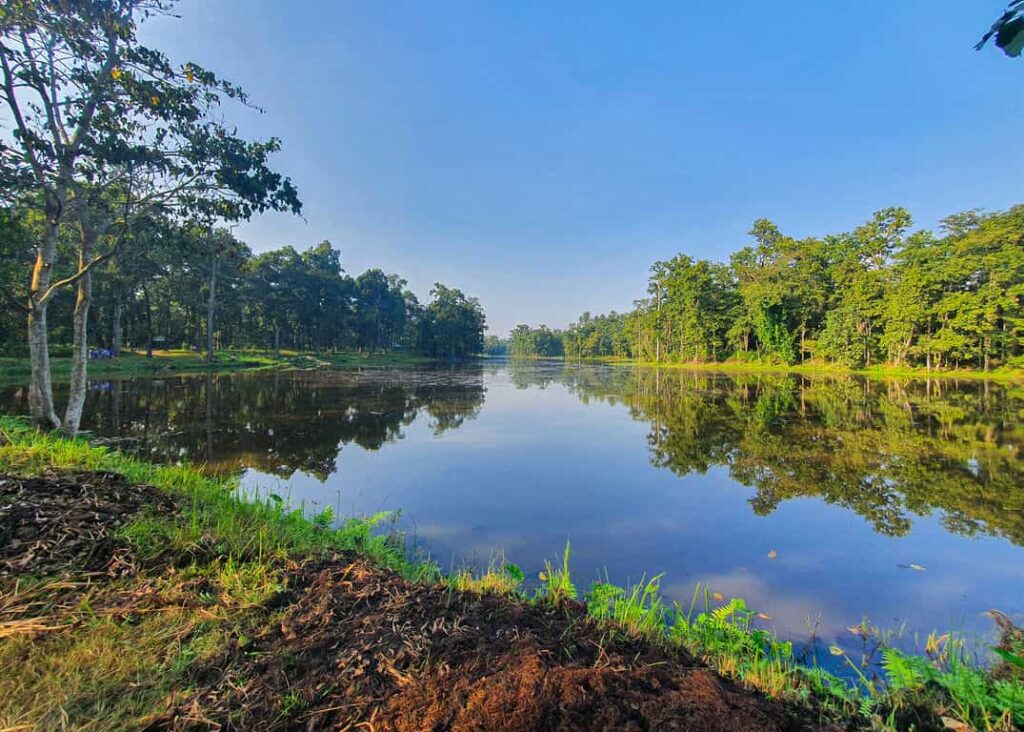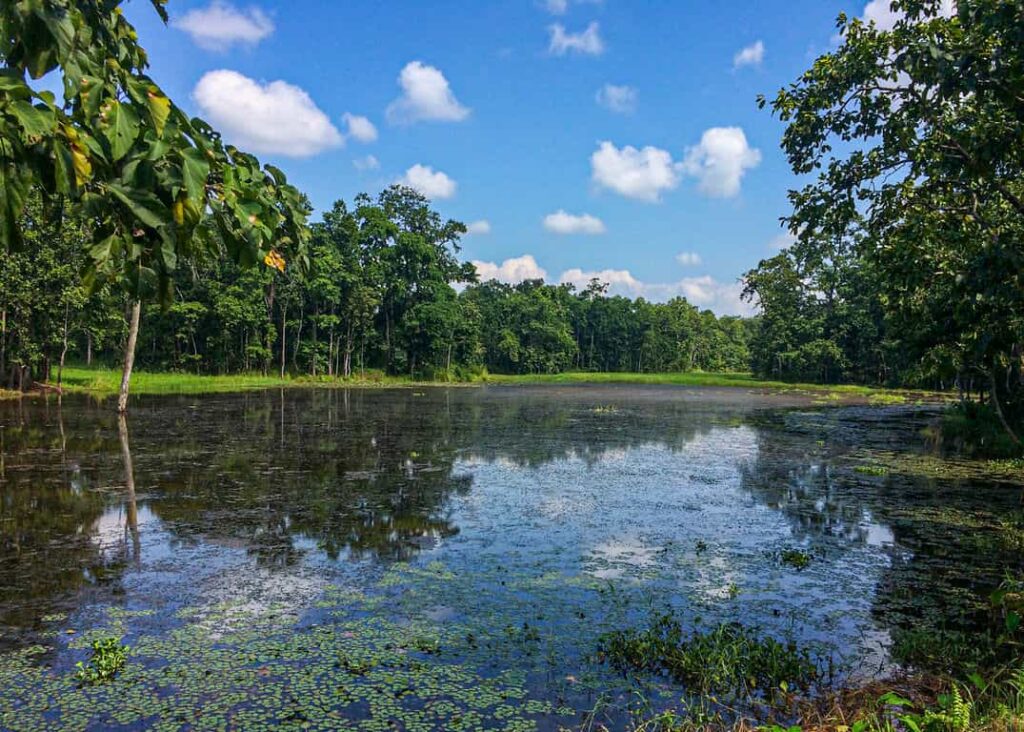Bis Hazari Lake is located at Bharatpur, the southern part of Chitwan National Park. The lake covers an area of 3200 ha and sits at an altitude of 286 m.
The lake is an important wetland habitat within the Chitwan National Park, providing a home for a variety of aquatic flora and fauna. It supports a diverse range of bird species, including migratory waterfowl. The Bis Hazari Lake is made up of 20000 small and big lakes so it is named ‘Bis Hazari’.
Things to know about Bis Hazari Lake
The lake is one of the sites travelers highly like to explore and relax. The lake is not extensively publicized, which is one of the negative aspects because this will hamper the entertainment possibilities for travelers and protect the flora and fauna around there. It can be a fantastic tourist destination because it is simply gorgeous and carries some good reason for its name. On the lake’s shores, there are few benches and waiting houses however the proper sanitation has not been carried out.

Since it is surrounded by beautiful vegetation and has millions of aquatic species. The lake can be the best destination for those who are seeking for nature tour. The lake and the surroundings of Chitwan National Park are protected areas, and conservation efforts are ongoing to maintain the ecological balance and biodiversity of the place.
Flora and fauna
Bis Hazari Lake is home to a variety of aquatic flora and fauna. The lake is compared with Chitwan National Park so similar flora and fauna can be found.
Flora:
- Aquatic plants: Water hyacinth, water lily, lotus, pondweed, duckweed
- Emergent vegetation: Cattails, reeds, sedges
- Riparian vegetation: Willows, banyan trees, figs
Fauna:
It has the Mammals:
- One-horned rhinoceros
- Bengal tiger
- Asian elephant
- Spotted deer
- Barking deer
- Nilgai (blue bull)
- Rhesus macaque
- Smooth-coated otter
Birds:
- Greater adjutant stork
- Painted stork
- Open-billed stork
- Spot-billed pelican
- Cormorants
- Herons
- Egrets
- Ducks (Mallard, Pintail, Garganey)
- Kingfishers
- Ibises
- Lapwings
- Gulls
- Terns
Reptiles:
- Marsh crocodile
- Indian python
- Monitor lizard
- Snakes (cobra, rat snake)
- Turtles
Amphibians:
- Bullfrogs
- Tree frogs
Fish:
- Rohu
- Catla
- Mrigal
- Grass carp
How to reach Bis Hazari Lake
It depends on where you start your journey and how you want to reach Bis Hazari Lake. You can take any vehicle there easily, you can rent a car or go on a quick bike adventure towards the lake. You can hire a car from Bharatpur or from Sauraha. One of the most important things is that if you travel by jeep or bike, you need to pay the National Park entry fee.
Also Read: Lakes of Nepal: Ghodaghodi Lake an eco-diverse Lake in Kailali
The entry fee costs NRs 150 for Nepali citizens. NRs 2000 for the foreigners who came to visit the lake from other countries. The discount is also given there for children who are below 10 years old.
Recreational activities
There are several activities and things to do around Bis Hazari Lake.
Boat Rides:
– Visitors can take guided boat tours on the calm waters of Bis Hazari Lake to observe the wildlife and birdlife up close. The boat rides provide opportunities to spot animals like one-horned rhinoceros, elephants, and crocodiles along the lakeshore.
Birdwatching:
– The lake is a haven for birdwatchers, with a variety of resident and migratory waterfowl and wading birds. Common sightings include storks, herons, egrets, cormorants, ducks, and even rare species like the greater adjutant stork.
Nature Walks:
– Hiking trails around the lake allow visitors to explore the surrounding wetlands, forests, and grasslands. These walks provide opportunities to spot wildlife and learn about the local flora and fauna.
Photography:
– The scenic beauty of Bis Hazari Lake, with its serene waters and diverse wildlife, makes it a prime photography destination. Visitors can capture stunning landscape shots, as well as closeup photos of the lake’s inhabitants.
You may also like: Tilicho Lake | One of the Cleanest Lakes in Nepal
Picnicking:
– The lakeside offers picnic spots where visitors can enjoy a meal while taking in the natural surroundings. Some designated picnic areas have basic facilities like seating and shelters.
Wildlife Viewing:
– Chitwan National Park, of which Bis Hazari Lake is a part, is known for its abundant wildlife. Visitors can spot animals like rhinoceros, tigers, elephants, and deer during safaris and excursions around the lake.
These activities allow visitors to fully immerse themselves in the natural wonders of the Bis Hazari Lake.
Best season to visit the lake
The ideal time to visit the lake is during winter, summer, and monsoon. Due to the absence of monsoon rains in the months of June till mid-September, the optimum time to visit Bis Hazari Lake is from September to May. October and early March this time has comfortable weather temperatures.

The hottest months to visit the lake are during April and May when temperatures range from 400c. due to the heat, the animals regularly came to the lake so visitors could easily observe the different animals. November, December, and January offer the best visibility while these seasons avoid the rain have cool temperatures, and also witness excellent Himalayan views.
Let our expert team at Asian Heritage Treks and Travel take care of everything — from guided tours to personalized packing tips and travel arrangements.
Plan My Nepal Trip







